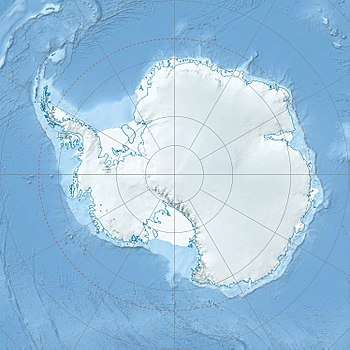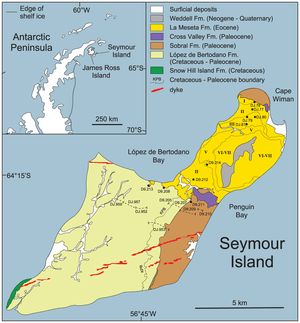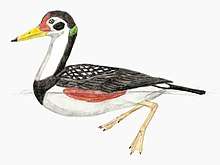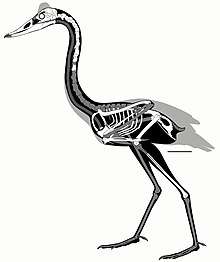Lopez de Bertodano Formation
The Lopez de Bertodano Formation is a geological formation in the James Ross archipelago of the Antarctic Peninsula. The strata date from the end of the Late Cretaceous (upper-lower Maastrichtian stage[1]) to the Danian stage of the lower Paleocene, from about 70 to 65.5 million years ago, straddling the Cretaceous-Paleogene boundary.[2]
| Lopez de Bertodano Formation Stratigraphic range: Maastrichtian-Danian ~70–65.5 Ma | |
|---|---|
| Type | Geological formation |
| Unit of | Marambio & Seymour Island Groups |
| Sub-units | Cape Lamb & Lower Sandwich Bluff Members |
| Underlies | Sobral Fm., La Meseta Fm. |
| Overlies | Snow Hill Island Formation |
| Lithology | |
| Primary | Siltstone, mudstone |
| Other | Sandstone with concretions |
| Location | |
| Coordinates | 64.0°S 57.4°W |
| Approximate paleocoordinates | 61.9°S 68.1°W |
| Region | Seymour Island, James Ross Island group |
| Country | Antarctica |
| Type section | |
| Named for | López de Bertodano Bay |
 Lopez de Bertodano Formation (Antarctica) | |
Cretaceous-Paleogene boundary

The Cretaceous–Paleogene boundary (K–Pg) crops out on Seymour Island in the upper levels of the Lopez de Bertodano Formation.[3] A small (but significant) iridium anomaly occurs at the boundary on Seymour Island, as at lower latitudes, thought to be fallout from the Chicxulub impactor in the Gulf of Mexico.[4] Directly above the boundary a layer of disarticulated fish fossils occurs, victims of a disturbed ecosystem immediately following the impact event.[3] Multiple reports have described evidence for climatic changes in Antarctica prior to the mass extinction,[5] but the extent to which these affected marine biodiversity is debated. Based on extensive marine fossil collections from Seymour Island, recent work has confirmed that a single and severe mass extinction event occurred at this time in Antarctica just as at lower latitudes.[6]
Fossil content
The Lopez de Bertodano Formation has provided many fossils of flora, dinosaurs and birds.[7][8][9] Also the first fossil egg from Antarctica, Antarcticoolithus, was found in the formation.[10]
Dinosaur remains are among the fossils that have been recovered from the formation[11] and include at least two and probably as much as six lineages of indisputably modern birds: one related to waterfowl, a primitive shorebird or related form, 1 to 2 species of possible loons, a large and possibly flightless bird belonging to a lineage extinct today as well as a partial skull that might belong to either of the smaller species or represent yet another one. The formation also contains a rich fossil invertebrate fauna, including bivalves, gastropods,[12] and cephalopods (ammonites and nautiloids).[13]
| Dinosaurs | |||||
|---|---|---|---|---|---|
| Genus | Species | Member | Material | Description | Image |
| Polarornis | P. gregorii | Lower Sandwich Bluff | Partial skull and skeleton, holotype | A loon?[11] | |
| P.? sp. | Lower Sandwich Bluff | Partial skeleton including wing and hindlimbs | Possibly a more primitive form with strong flight ability and lighter bones | ||
| Vegavis | V. iaai[14] | Lower Sandwich Bluff | Partial skeleton, holotype | An anseriform |  |
| V. sp. | Cape Lamb | Isolated femur | Initially identified as a fossil of a member of Cariamae,[15] but subsequently reinterpreted as a fossil of an unnamed large-bodied member of the genus Vegavis.[16] | ||
| Conflicto | C. antarcticus | Partial skeleton | An anseriform |  | |
| Morrosaurus[17] | M. antarcticus | An elasmarian ornithopod | |||
| Undescribed charadriiform[18] | Unnamed species | Cape Lamb | Partial skeleton | ||
| Unidentified Neornithes | Unnamed species | Partial skull | Relationships undetermined, cranium some 5–6 centimetres (2.0–2.4 in) long | ||
| Undescribed hadrosaurid | Unnamed species | Isolated tooth[1] | |||
| Undescribed non-avian theropod | Unnamed species | Fragments[1] | |||
Other fossils
Among others, the following fossils have been found in the formation:
- Ammonites[13]
- Diplomoceras cylindraceum
- Gaudryceras seymouriense
- Grossouvrites joharae
- Kitchinites laurae
- Maorites densicostatus
- Pachydiscus (Pachydiscus) ultimus
- Zelandites varuna
- Pseudophyllites cf. loryi
- Other invertebrates
- Eutrephoceras dorbignyanum
- Rotularia fallax
- Cyathocidaris nordenskjoldi, C. patera
- Flora
- Antarctoxylon juglandoides
- Eucryphiaceoxylon eucryphioides
- Myrceugenelloxylon antarcticus
- pollen
See also
References
- Olivero, E.B.; Ponce, J.J.; Marsicano, C.A.; Martinioni, D.R. (2007). "Depositional settings of the basal Lopez de Bertodano Formation, Maastrichtian, Antarctica". Revista de la Asociación Geológica Argentina. 62 (4): 521–529.
- Bowman, V.; Ineson, J.; Riding, J.; Crame, J.; Francis, J.; Condon, D.; Whittle, R.; Ferraccioli, F. (2016). "The Paleocene of Antarctica: Dinoflagellate cyst biostratigraphy, chronostratigraphy and implications for the palaeo-Pacific margin of Gondwana". Gondwana Research. 38: 132–148. Bibcode:2016GondR..38..132B. doi:10.1016/j.gr.2015.10.018.
- Zinsmeister, W.J. (1998). "Discovery of fish mortality horizon at the K-T Boundary on Seymour Island: Re-evaluation of events at the end of the Cretaceous". Journal of Paleontology. 72 (3): 556–571. doi:10.1017/S0022336000024331.
- Elliot D.H.; Askin RA; Kyte FT; Zinsmeister WJ (1994). "Iridium and dinocysts at the Cretaceous-Tertiary boundary on Seymour Island, Antarctica: Implications for the K-T event". Geology. 22 (8): 675. Bibcode:1994Geo....22..675E. doi:10.1130/0091-7613(1994)022<0675:IADATC>2.3.CO;2.
- Petersen, S.V.; Dutton A; Lohmann KC (2016). "End-Cretaceous extinction in Antarctica linked to both Deccan volcanism and meteorite impact via climate change". Nature Communications. 7: 12079. Bibcode:2016NatCo...712079P. doi:10.1038/ncomms12079. PMC 4935969. PMID 27377632.
- Witts J.D.; Whittle RJ; Wignall PB; Crame JA; Francis JE; Newton RJ; Bowman VC (2016). "Macrofossil evidence for a rapid and severe Cretaceous-Paleogene mass extinction in Antarctica". Nature Communications. 7: 11738. Bibcode:2016NatCo...711738W. doi:10.1038/ncomms11738. PMC 4894978. PMID 27226414.
- Marambio Group - Lopez de Bertodano Formation at Fossilworks.org
- Seymour Island Group - Lopez de Bertodano Formation at Fossilworks.org
- Upper Lopez de Bertodano Formation at Fossilworks.org
- Legendre et al., 2020
- Weishampel, David B; et al. (2004). "Dinosaur distribution (Late Cretaceous, Antarctica)." In: Weishampel, David B.; Dodson, Peter; and Osmólska, Halszka (eds.): The Dinosauria, 2nd, Berkeley: University of California Press. p. 606. ISBN 0-520-24209-2.
- Crame, J.A.; Beu, A.G.; Ineson J.R.; Francis J.A.; Whittle R.J.; Bowman V.C. (2014). "The Early Origin of the Antarctic Marine Fauna and Its Evolutionary Implications". PLOS ONE. 7 (12): e114743. Bibcode:2014PLoSO...9k4743C. doi:10.1371/journal.pone.0114743. PMC 4262473. PMID 25493546.
- Witts, J.D.; Bowman V.C.; Wignall P.B.; Crame J.A.; Francis, J.E.; Newont, R.J. (2015). "Evolution and extinction of Maastrichtian (Late Cretaceous) cephalopods from the López de Bertodano Formation, Seymour Island, Antarctica" (PDF). Palaeogeography, Palaeoclimatology, Palaeoecology. 418: 193–212. Bibcode:2015PPP...418..193W. doi:10.1016/j.palaeo.2014.11.002.
- Clarke, J.A.; Tambussi, C.P.; Noriega, J.I.; Erickson, G.M.; Ketcham, R.A. (2005). "Definitive fossil evidence for the extant avian radiation in the Cretaceous" (PDF). Nature. 433 (7023): 305–308. Bibcode:2005Natur.433..305C. doi:10.1038/nature03150. PMID 15662422. Supporting information
- Case, J.; Reguero, M.; Martin, J.; Cordes-Person, A. (2006). "A cursorial bird from the Maastrictian of Antarctica". Journal of Vertebrate Paleontology. 26 (3): 48A. doi:10.1080/02724634.2006.10010069.
- Abagael R. West; Christopher R. Torres; Judd A. Case; Julia A. Clarke; Patrick M. O'Connor; Matthew C. Lamanna (2019). "An avian femur from the Late Cretaceous of Vega Island, Antarctic Peninsula: removing the record of cursorial landbirds from the Mesozoic of Antarctica". PeerJ. 7: e7231. doi:10.7717/peerj.7231. PMC 6626523. PMID 31333904.
- Rozadilla, Sebastián; Agnolin, Federico L.; Novas, Fernando E.; Aranciaga Rolando, Alexis M.; Motta, Matías J.; Lirio, Juan M.; Isasi, Marcelo P. (2016). "A new ornithopod (Dinosauria, Ornithischia) from the Upper Cretaceous of Antarctica and its palaeobiogeographical implications". Cretaceous Research. 57: 311–324. doi:10.1016/j.cretres.2015.09.009.
- Cordes (2002). "A new charadriiform avian specimen from the Early Maastrichtian of Cape Lamb, Vega Island, Antarctic Peninsula". Journal of Vertebrate Paleontology. 22 (3): 46A.
Bibliography
- Legendre, Lucas J.; David Rubilar Rogers; Grace M. Musser; Sarah N. Davis; Rodrigo A. Otero; Alexander O. Vargas, and Julia A. Clarke. 2020. A giant soft-shelled egg from the Late Cretaceous of Antarctica. Nature .. .. Accessed 2020-06-17.
Further reading
- Poole, I.; Mennega, A. M. W.; Cantrill, D. J. (2003). "Valdivian ecosystems in the Late Cretaceous and Early Tertiary of Antarctica: further evidence from myrtaceous and eucryphiaceous fossil wood". Review of Palaeobotany and Palynology. 124: 9–27. doi:10.1016/s0034-6667(02)00244-0.